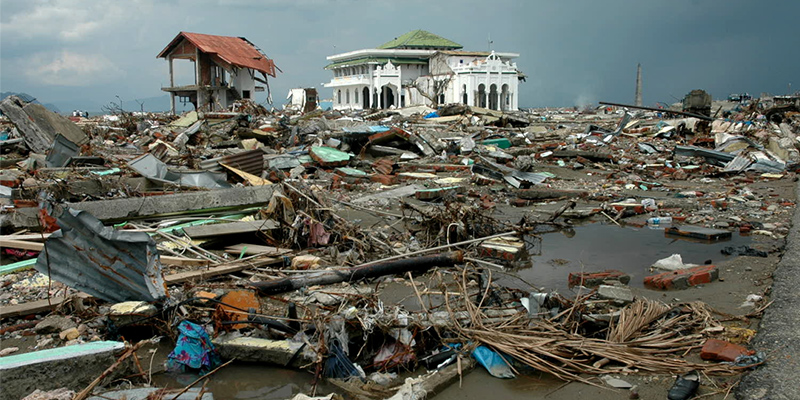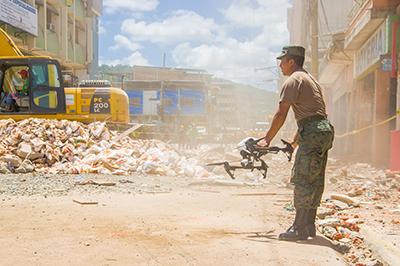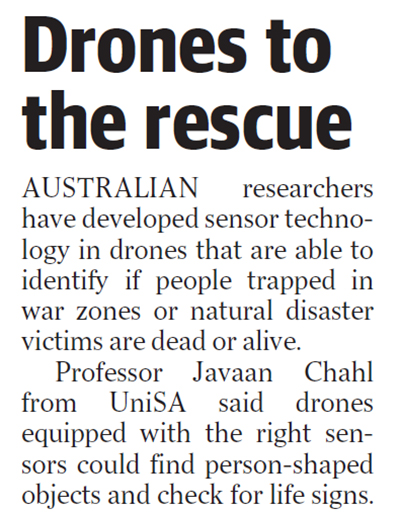World first study with drone cameras able to identify survivors
By Candy Gibson
 TECHNOLOGY AND ENGINEERING Researchers have developed a more accurate drone camera system to detect signs of life that will help find survivors in disaster zones. This image is from the devastating earthquake and tsunami in Banda Aceh, Indonesia on 26 December 2004. Photo: Frans Delian / Shutterstock.com
TECHNOLOGY AND ENGINEERING Researchers have developed a more accurate drone camera system to detect signs of life that will help find survivors in disaster zones. This image is from the devastating earthquake and tsunami in Banda Aceh, Indonesia on 26 December 2004. Photo: Frans Delian / Shutterstock.comAn improved drone system can separate the living from the dead by detecting tiny chest movements.
 A drone is used by the Ecuadorian army to search for survivors after a 7.8 earthquake Portoviejo, Ecuador in April 2016. Researchers from UniSA and Middle Technical University have developed a more accurate camera system to detect signs of life. Photo: Fotos593 / Shutterstock.com
A drone is used by the Ecuadorian army to search for survivors after a 7.8 earthquake Portoviejo, Ecuador in April 2016. Researchers from UniSA and Middle Technical University have developed a more accurate camera system to detect signs of life. Photo: Fotos593 / Shutterstock.comAutonomous drone cameras have been trialled for several years to detect signs of life in disaster zones but in a world first study, researchers from Adelaide and Iraq have taken this a step further.
Using a new technique to monitor vital signs remotely, engineers from UniSA and Middle Technical University in Baghdad have designed a computer vision system that can distinguish survivors from deceased bodies from 4-8 metres away.
As long as the upper torso of a human body is visible, the cameras can pick up the tiny movements in the chest cavity, that indicate a heartbeat and breathing rate. Unlike previous studies, the system doesn’t rely on skin colour changes or body temperature.
The breakthrough is a more accurate means of detecting signs of life, the researchers say.
UniSA Professor Javaan Chahl and Dr Ali Al-Naji, the study leaders, made global headlines in 2017 when they showed for the first time that a camera on a drone could measure heart and respiratory rates.
At the time, their technique was based on detecting changes in human skin tone and the camera needed to be within 3m of the person. The technique was also limited to one pose where the subject stood in front of the drone, not lying prone as it would be in a disaster zone.
 The Courier Mail Brisbane 28 October 2019
The Courier Mail Brisbane 28 October 2019Other techniques using thermal cameras can only detect signs of life where there is a contrast between the body temperature and the background, making this difficult in warm environments. Thermal cameras are also unreliable where people are wearing insulated clothing.
“This study, based on cardiopulmonary motion, is the first of its type and was performed using eight people (four of each gender) and a mannequin, all lying on the ground in different poses,” Prof Chahl says.
“Videos were taken of the subjects in daylight, up to eight metres away, and in relatively low wind conditions for one minute at a time, with the cameras successfully distinguishing between the live bodies and the mannequin.”
Prof Chahl says the technology could be used to monitor for signs of life where time is critical, helping first responders in their search to find survivors in disaster zones.
“This system would be ideal for many situations, including earthquakes and floods, nuclear disasters such as Fukushima, chemical explosions, bio attacks, mass shootings, combat search and rescue or where a plane has crashed in a remote area.”
Current ground-based operations for rescuing survivors in disaster zones include using rescue robots and rescue dogs, which are expensive and hampered by restricted access.
He says the motion-based system needs additional testing in adverse weather conditions and to ensure accurate readings when bodies are partially obscured.
The findings are published in Remote Sensing.
UniSA and Middle Technical University researcher Dr Ali Al-Naji and UniSA PhD student Asanka Perera led the study with MTU’s Assistant Professor Saleem Latteef Mohammed. The study was directed by UniSA Professor Javaan Chahl, who has a joint appointment with the Defence, Science and Technology Group.
Other Stories
- UniSA researchers to help NASA monitor health in space
- Great career prospects for UniSA graduates, new government data shows
- Parents left in the cold when it comes to kids with autism
- New multilevel homes become heat traps in summer
- From the Vice Chancellor
- Achievements and Announcements
- World first study with drone cameras able to identify survivors
- Wastewater study pinpoints cities across the world with high drug use
- UniSA ranked top in SA for Education, Law, Business and Economics
- Opportunity for almost 200 UniSA students to study in Indo-Pacific in 2020
- Intensive course empowers women impacted by domestic violence and homelessness
- The magic that happens when a nanoengineer and immunologist collaborate
- UniSA takes reins on world first Invictus Pathways Program for Aussie veterans and first responders
- New Social Enterprise Hub to foster social innovation and entrepreneurship
- New partnership with MIT to underpin data visualisation research
- UniSA Vietnamese law student wins SA’s top honour
- The latest books from UniSA researchers
- UniSA Alumni Awards and UniSA Research Day
- Australia’s drought relief package hits the political spot but misses the bigger point
- Relive the Hawke Centre’s latest events
- Read the latest edition of unisabusiness magazine
- Read the latest edition of enterprise magazine




